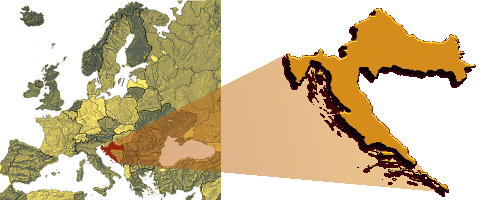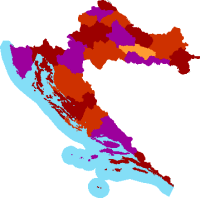
Home

Split, Gorans home town, anxiously awaits the return of their Wimbledon hero, July 2001
Croatia is geographically situated on the cross-roads between Central Europe and the Mediterranean:

General Information
Official name: Republic of Croatia
Official language: Croatian
Alphabet: Latin
Currency: Kuna (100 lipa)
Population: (1991.) 4,784,000 (2,465,000 female, 2,319,000 male)
Number of islands: 1,185 (66 inhabited)
Capital: Zagreb (nearly 1 million inhabitants)
Political system: Parlamentary multiparty Republic
Area:
Total state area: 89,810 km2
Teritory area (land:) 56,610 km2
Aquatorium area (internal sea line): 33,200 km2
Marine economy region (teritorial sea line): 23,870 km2
Total economy area: 113,680 km2
Coastline length: 5,835 km
Coastline length of mainland: 1,777 km
Coastline length of islands: 4,058 km
Teritorial-administrative structure:
20 counties and the Town of Zagreb with 121 towns and 416 communities
Counties
|
Zagreb Krapina and Zagorje Sisak and Moslavina Karlovac Varazdin Koprivnica and Krizevci Bjelovar and Bilogora Rijeka Lika and Senj Virovitica and Podravina Pozega and Slavonia Slavonski Brod and Posavina Zadar Osijek and Baranja Sibenik and Knin Vukovar and Srijem Split and Dalmatia Istria Dubrovnik and Neretva Medjimurje |
 |
The Republic of Croatia's national anthem is "Lijepa nasa domovino" ("Our Beautiful Homeland"). Antun Mihanovic is the author of the lyrics.
Flag and Coat-of-Arms:
 The Croatian National flag is red-white-blue tricolor (arranged in this order perpendicularly to the staff), with the coat of arms (13 red squares and 12 silver squares arranged intermittently in a 5 times 5 pattern).
The Croatian National flag is red-white-blue tricolor (arranged in this order perpendicularly to the staff), with the coat of arms (13 red squares and 12 silver squares arranged intermittently in a 5 times 5 pattern). This coat of arms was affirmed by 15th century documents. It is a very old symbol of Croatia ressembling a red-white chess table. Now it also has a crown composed of five regional symbols representing 1) The oldest known Croatian coat of arms, 2) Dubrovnik, 3) Dalmatia, 4) Istria and 5) Slavonia.
This coat of arms was affirmed by 15th century documents. It is a very old symbol of Croatia ressembling a red-white chess table. Now it also has a crown composed of five regional symbols representing 1) The oldest known Croatian coat of arms, 2) Dubrovnik, 3) Dalmatia, 4) Istria and 5) Slavonia.Culture:
Belonging to the Middle-European and Mediterranean cultural and civilisation circle and tradition. Extremely rich and valuable cultural and historical heritage is pointing
 to a millenium old presence of Croatia in the area.
to a millenium old presence of Croatia in the area.The specific urban culture of coastal and island areas is easily seen in towns such as: Porec, Rovinj, Pula, Zadar, Sibenik, Hvar, Korcula and Ston, with Split (Diocletian's Palace) and Dubrovnik representing a part of the world cultural heritage under UNESCO protection.
Climate:
Northern Croatia has a continental climate. Central, semimountainous and mountainous regions, as well as the entire Adriatic coast, have a Mediterranean climate. Spring and autumn are mild along the coast, while winter can be cold and snowy in central and northern regions.
Religions:
Roman-Catholics, Orthodox, Muslim, Jews, Protestants, others
Visit Source